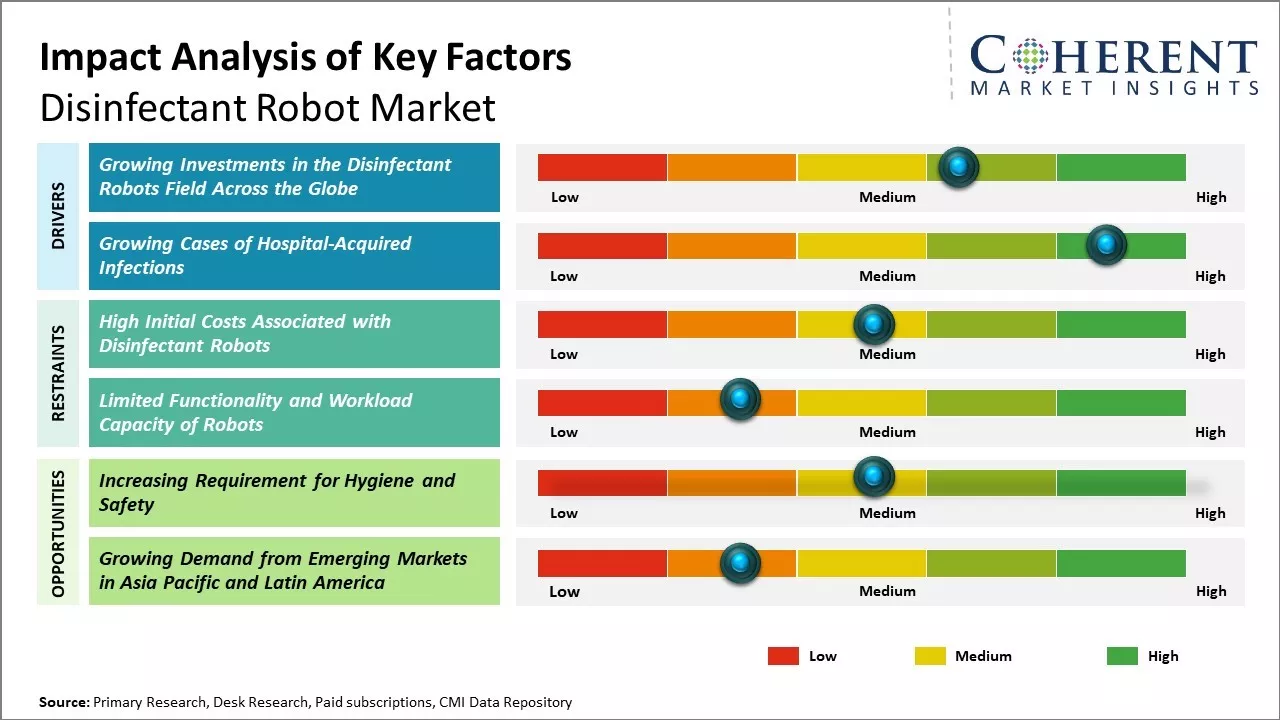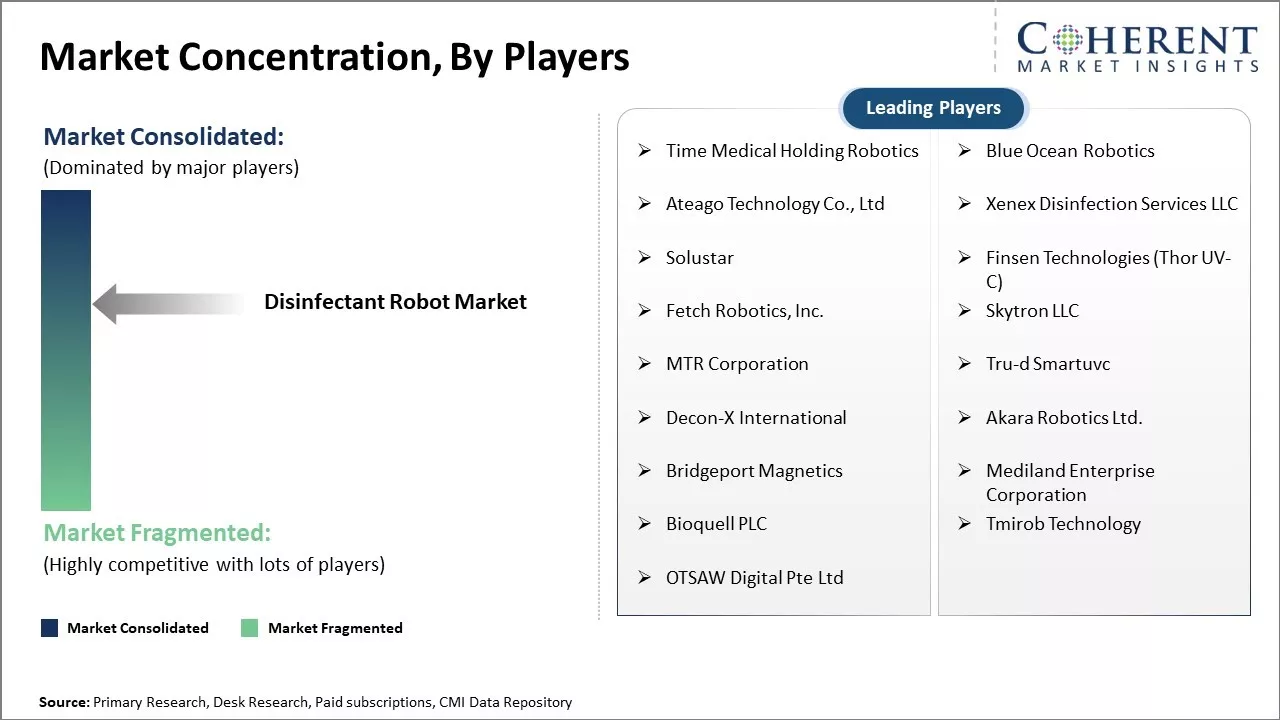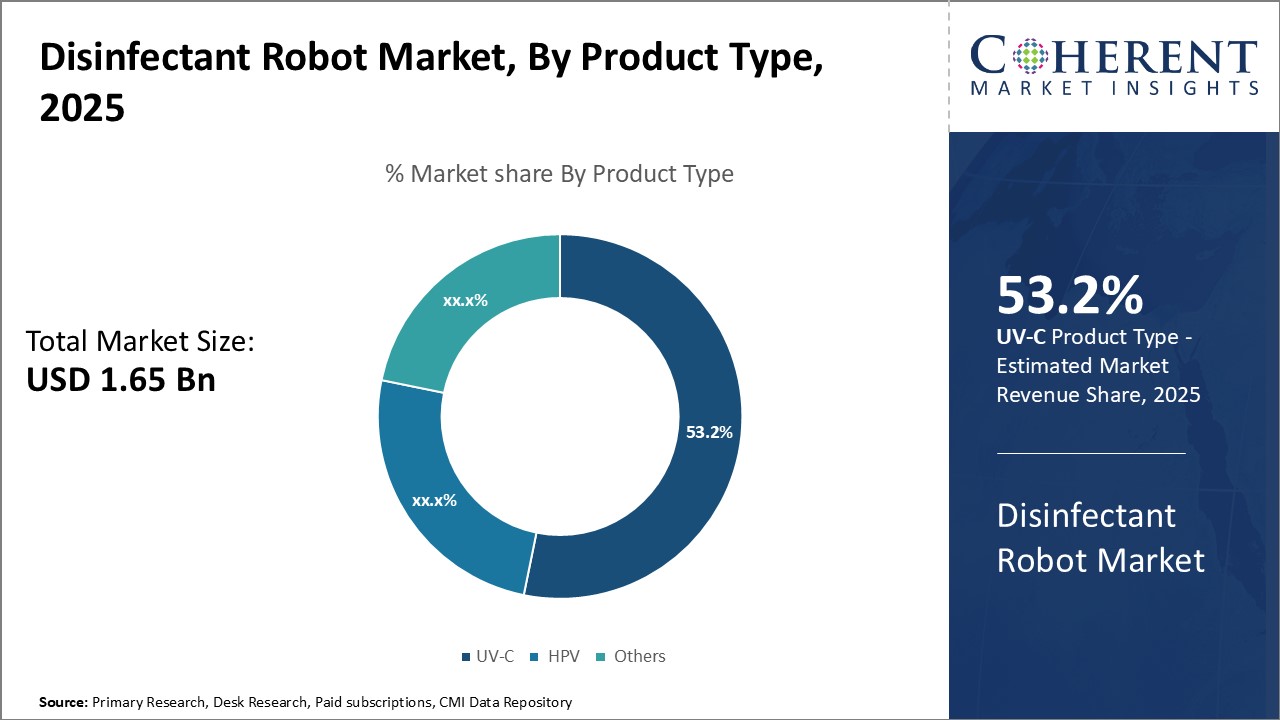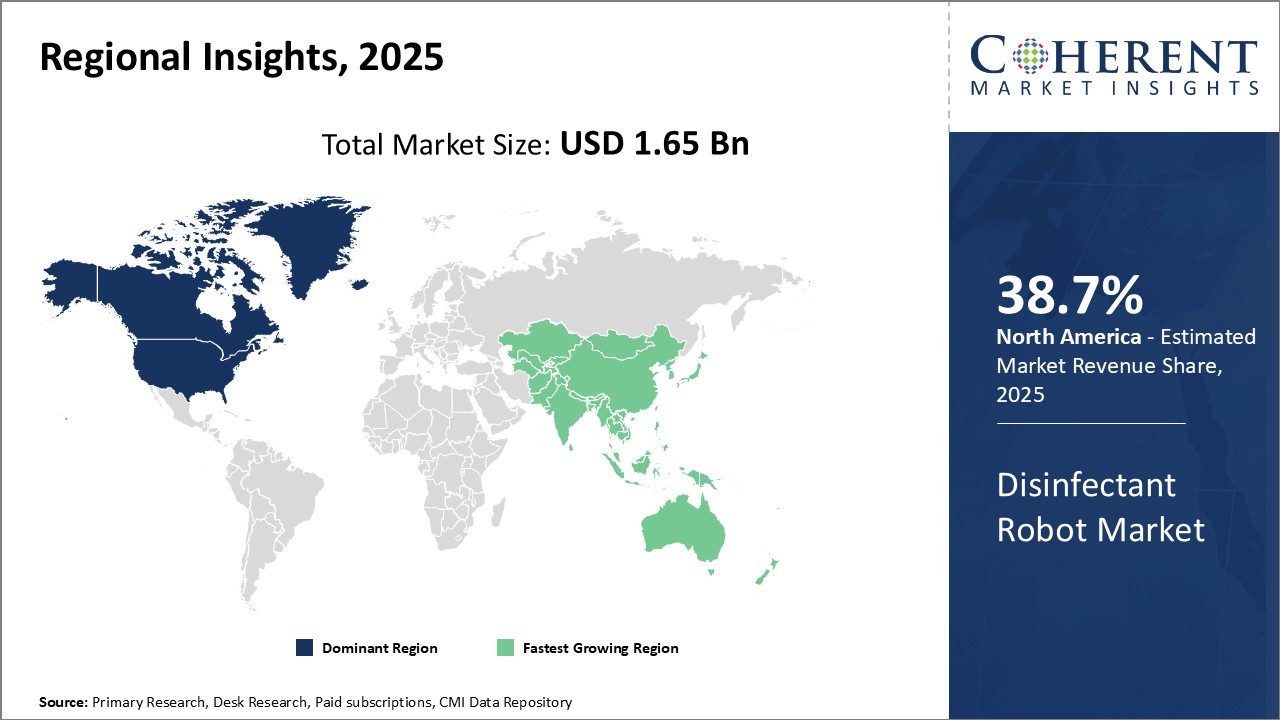Global disinfectant robot market is estimated to be valued at USD 1.65 Bn in 2025 and is expected to reach USD 7.87 Bn by 2032, exhibiting a compound annual growth rate (CAGR) of 25.0% from 2025 to 2032.

Discover market dynamics shaping the industry: Download Free Sample
There has been rising demand for disinfection robots due to growing prevalence of hospital acquired infections worldwide. The COVID-19 pandemic has further accelerated the adoption of disinfection robots as a preventive measure against virus spread. Various advancements including UV-C technology integration and autonomous navigation are enhancing the disinfection capabilities of these robots.
Growing investments in the disinfectant robots field across the globe
Growing investments in the disinfectant robots field across the globe is expected to drive the global disinfectant robot market growth over the forecast period. For instance, on January 5, 2022, The Blue Ocean Company, a technology enablement company, announced that it had received US$ 50.94 million funding from A.P. Møller Holding, the investment arm of A.P. Møller-Maersk, an international logistics company, -to develop and commercialize mobile robots to improve productivity, the working environment, sustainability, and the quality of customer service.

Get actionable strategies to beat competition: Download Free Sample
Growing Cases of Hospital-Acquired InfectionsGrowing cases of hospital-acquired infections is expected to drive the global disinfectant robot market growth over the forecast period. Healthcare industry across the globe is increasingly facing significant issues of hospital-acquired infections (HAI). Numerous patients suffer from HAI every year and it causes several deaths around the world. Due to HAIs, the hospitalization period of a patient increases, and this increases the total hospital cost for the patient. Thus, demand for disinfectant robots is increasing in hospitals around the world.
Key Takeaways from Analyst
Global disinfectant robot market growth is driven by ongoing COVID-19 pandemic, as there is increased awareness about the importance of disinfection and sanitization. Healthcare institutions and other commercial spaces are actively seeking automated disinfection solutions to limit the spread of infections. This boosts demand for disinfectant robots globally.
High initial costs of these robotic solutions can hamper the market growth. Many organizations may not see disinfectant robots as cost-effective unless there are subsequent outbreaks. The concerns around technology limitations and effectiveness can hamper its widespread acceptance.
Ongoing government support and investments towards improving hygiene infrastructure can offer opportunities for disinfectant robot vendors. Successful demonstration projects by early adopters can address efficacy concerns and shore up credibility. Asia Pacific is expected to emerge as the fastest growing regional market due to increasing healthcare expenditure and ongoing smart city projects in major countries like China and India.
Market Challenges: Limited Functionality and Workload Capacity of Robots
Limited functionality and workload capacity of disinfectant robots can hamper the global disinfectant robot market growth. While disinfectant robots can reduce the risk of infections and provide improved sanitization as compared to manual methods, their narrow set of capabilities means these cannot match the flexibility and range of tasks that human cleaners can perform. Most disinfectant robots currently available are equipped with only ultraviolet lights or disinfecting sprayers. Their speed of disinfection and area coverage is often slow as these need to thoroughly sterilize room surfaces one by one. This makes disinfecting larger and more complex spaces like hospitals an inefficient process. The robots also have difficulty navigating obstructed areas or spaces with irregular layouts without human guidance. As a result, for optimal performance these still require partial human support and supervision. This defeats some key purposes of automation and adds to production costs.
Market Opportunities: Increasing Requirement for Hygiene and Safety
Increasing requirement for hygiene and safety can offer growth opportunities for market players in the global disinfectant robot market over the forecast period. The need for safety and hygiene has increased significantly due to the COVID-19 pandemic. It lead to rise in adoption of disinfectant robots in several industries. Market vendors pivoted from healthcare-based solutions towards commercial facilities. Moreover, private business owners and public agencies are increasingly focusing on disinfection robots for ensuring safety public workplaces and facilities without any additional labor costs.

Discover high revenue pocket segments and roadmap to it: Download Free Sample
Insights, By Product Type: An indispensable solution in the fight against hospital-acquired infectionsProduct Type segment is sub-segmented into UV-C, HPV, and others. UV-C sub-segment is estimated to hold 53.2% of the market share in 2025, owing to its proven effectiveness in killing pathogens. UV-C light can destroy the DNA and RNA of microbes, thus, eliminating viruses, bacteria, and fungi on surfaces. Independent testing has demonstrated that UV-C can reduce microbes including MRSA, C. difficile, and norovirus by over 99%, thus, making it a go-to technology for disinfection in healthcare facilities. With traditional cleaning and disinfecting methods unable to curb the spread of “superbugs,” hospitals are urgently searching for automated solutions like UV-C robots that can disinfect 100% of surfaces quickly and effectively around the clock. UV-C robots allow for continuous round-the-clock disinfection without interrupting patient care or exposing staff, thus, providing hospitals a powerful tool in preventing the onset and transmission of antimicrobial-resistant infections.
Insights, By End User: Early adopters of disinfection robotics
End User segment is sub-segmented into hospitals, pharmaceutical companies, and others. Hospitals sub-segment is estimated to hold 44% of the market share in 2025 due to their pressing need to curb hospital-acquired or nosocomial infections that endanger patient safety. Hospital-acquired infections affect millions of patients annually worldwide, thus, prolonging hospital stay and dramatically increasing medical costs. Growth of antibiotic-resistant pathogens has made existing cleaning protocols ineffective and endangered standard disinfection practices. Faced with this imminent threat, hospitals have been quick to adopt the latest technologies like automated disinfecting robots that deploy cutting-edge UV-C light or HP vapor technologies to disinfect entire patient rooms and high-touch surfaces uninterrupted. Robots allowing 24/7 disinfection help fill in gaps in manual cleaning schedules while ensuring complete coverage of all areas. Their objectively verifiable disinfection efficacy provides hospital administrators and boards confidence that an additional line of defense is actively safeguarding patients, staff and hospital quality metrics from the risk of antimicrobial resistance.

Need a Different Region or Segment? Download Free Sample
North America is the dominant region in the global disinfectant robot market and is estimated to hold 38.7% of the market share in 2025. Rising awareness about hospital-acquired infections among patients and medical staff is expected to drive the market growth. With the COVID-19 pandemic highlighting the need for advanced disinfection technologies, there has been rising adoption of robot adoption across healthcare facilities. The region is home to many leading robotics developers including Xenex, Blue Ocean Robotics and UVD Robots - all of which have strengthened their presence through multiple product launches, catering to North American requirements. Regulatory frameworks such as CADRA (Canadian Association of Disinfection and Reprocessing) have standardized disinfection guidelines, thus, boosting robot purchases. Increasing collaborations between robotic vendors and healthcare systems is expected to drive the market growth.
Asia Pacific has emerged as the fastest growing regional market due to improving public health standards, rising medical tourism and growing infrastructure development across the healthcare sector in Asia's developing economies. Countries like China and India are prioritizing hospital infrastructure upgradation to prevent infections, while also promoting localized robot manufacturing under initiatives like 'Make in India'. This has provided Asian robotics companies an opportunities to innovate affordable and customized solutions. Trade deals under agreements like RCEP are aiding cross-border collaboration and robot component sharing within the region. Factors like relatively lenient regulatory processes and low labor costs makes Asia an attractive production base for global players wanting to increase their regional footprint.
Disinfectant Robot Market Report Coverage
| Report Coverage | Details | ||
|---|---|---|---|
| Base Year: | 2024 | Market Size in 2025: | USD 1.65 Bn |
| Historical Data for: | 2020 To 2024 | Forecast Period: | 2025 To 2032 |
| Forecast Period 2025 to 2032 CAGR: | 25.0% | 2032 Value Projection: | USD 7.87 Bn |
| Geographies covered: |
|
||
| Segments covered: |
|
||
| Companies covered: |
Time Medical Holding Robotics, Blue Ocean Robotics, Ateago Technology Co., Ltd, Xenex Disinfection Services LLC, Solustar, Finsen Technologies (Thor UV-C), Fetch Robotics, Inc., Skytron LLC, MTR Corporation, Tru-d Smartuvc, Decon-X International, Akara Robotics Ltd., Bridgeport Magnetics, Mediland Enterprise Corporation, Bioquell PLC, Tmirob Technology, OTSAW Digital Pte Ltd |
||
| Growth Drivers: |
|
||
| Restraints & Challenges: |
|
||
Uncover macros and micros vetted on 75+ parameters: Get instant access to report
*Definition: Disinfectant Robot is a futuristic machine that sprays disinfectant in public places and has the capability of operating autonomously. These robots are expected to improve patient safety, decrease labor costs, and reduce the number of contagious germs.
Share
Share
About Author
Manisha Vibhute is a consultant with over 5 years of experience in market research and consulting. With a strong understanding of market dynamics, Manisha assists clients in developing effective market access strategies. She helps medical device companies navigate pricing, reimbursement, and regulatory pathways to ensure successful product launches.
Missing comfort of reading report in your local language? Find your preferred language :
Transform your Strategy with Exclusive Trending Reports :
Frequently Asked Questions
Joining thousands of companies around the world committed to making the Excellent Business Solutions.
View All Our Clients